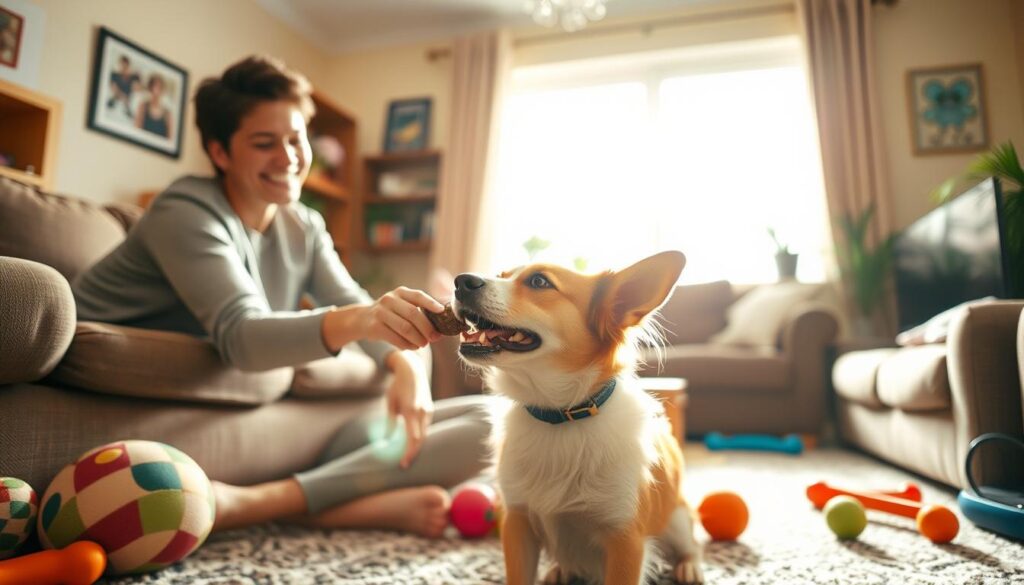Ever wondered what’s going on in your pet’s mind? Knowing their psychology is key to a stronger bond. This guide explores pet psychology, helping you understand and meet your pet’s needs. Pet Psychology
Pet psychology looks at the complex bond between humans and animals. It uncovers the cognitive, emotional, and behavioral aspects that affect a pet’s happiness. By diving into this field, you’ll learn how to care for your pet better and create a happy environment for them.

Key Takeaways
- Discover the fundamental principles of pet psychology and how they impact your pet’s behavior and emotional well-being.
- Explore the intricate connection between humans and their pets, and learn how to foster a deeper, more meaningful bond.
- Understand the factors that influence your pet’s behavior, from genetics and environment to training and socialization.
- Identify and address common behavioral issues, such as aggression, anxiety, and destructive behavior, with effective, positive-reinforcement techniques.
- Learn to recognize and respond to your pet’s emotional cues, ensuring their overall happiness and well-being.
What is Pet Psychology?
Pet psychology is the study of how animals behave and think. It covers many topics, like what drives animal behavior and their emotional lives. It helps us understand our pets better. Pet Psychology
Definition and Scope
Pet psychology looks at how animals think, act, and feel. It studies what influences their behavior and how they interact with us. It’s about understanding a cat’s purr or a dog’s body language.
Importance for Pet Owners
Knowing pet psychology is key for pet owners. It helps build a stronger bond with your pet and solve behavior problems. It teaches you how to communicate and care for your pet better. Pet Psychology
| Key Aspects of Pet Psychology | Importance for Pet Owners |
|---|---|
| Cognitive processes Emotional responses Behavioral patterns Communication methods | Stronger pet-owner bond Effective behavior modification Improved training techniques Enhanced pet well-being |
“Understanding your pet’s behavior and mental processes is the key to a fulfilling and harmonious relationship.”
The Connection Between Pets and Humans
The bond between pets and humans is amazing. It has caught the attention of researchers for years. This deep connection shapes how we talk and interact with our pets. Pet Psychology
Emotional Bonds
Pets do more than just keep us company. They offer emotional support and help reduce stress. They can even make us feel better overall.
The love and friendship we share with pets can greatly improve our health. This connection goes beyond just being friends.
Non-Verbal Communication
Good communication is key in the human-animal bond. Pets may not speak our language, but they communicate in their own way. By watching their body language and sounds, we can understand what they’re feeling. Pet Psychology
- Tail wagging, ear position, and eye contact can convey a pet’s mood and feelings.
- Purring, meowing, or barking may indicate a pet’s desire for attention, food, or playtime.
- Yawning, panting, or cowering can signal stress or discomfort, prompting the owner to provide comfort or address the issue.
Learning to understand non-verbal cues can make our bond with pets stronger. It helps us meet their needs better, making our relationship more fulfilling. Pet Psychology
By building a strong emotional connection and understanding pet communication, we can make our bond with pets even better. This creates a rewarding and enriching partnership. Pet Psychology
Factors Influencing Pet Behavior
Understanding what shapes pet behavior is key for pet owners. It helps create a good bond with their pets. Genetics, environment, and training all play a part in a pet’s personality and behavior.
Genetics
A pet’s genes greatly influence its behavior and temperament. Some breeds have natural traits, like herding in dogs or independence in cats. Knowing these traits helps owners better connect with their pets.
Environment
The environment a pet grows up in affects its behavior a lot. Things like socialization and consistent routines are important. A stable, enriching environment leads to well-adjusted pets.
Training
Training is vital in shaping pet behavior. Positive reinforcement helps teach good habits and builds trust. Regular training keeps the household peaceful and happy.
Understanding genetics, environment, and training helps owners improve their pets’ lives. It ensures a strong and happy human-animal bond.

“The better you understand your pet’s behavior, the more you can tailor your approach to meet their unique needs and create a fulfilling and harmonious relationship.”
Common Behavioral Issues
Knowing about common behavioral issues is key for a good bond with our pets. These issues include aggression, anxiety, and destructive behavior. Pet psychology helps solve these problems and keeps pets happy and healthy.
Aggression
Aggression in pets can come from fear, wanting to protect their territory, or not being social enough. By figuring out why and using the right training, we can help our pets feel better.
Anxiety
Pet anxiety shows up in many ways, like barking too much, chewing things up, or getting upset when left alone. Knowing what makes them anxious and creating a safe space can help them feel more at ease.
Destructive Behavior
Chewing, digging, or scratching can be tough for pet owners. But, by understanding why they do it and using the right pet psychology methods, we can stop these behaviors and teach them new ones.
Fixing behavioral issues needs a detailed plan that fits each pet’s needs. By knowing the reasons behind their actions and using effective strategies, we can have a happy and loving relationship with our pets.
| Behavioral Issue | Potential Causes | Recommended Strategies |
|---|---|---|
| Aggression | Fear, Territoriality, Lack of Socialization | Positive Reinforcement Training, Gradual Exposure, Socialization |
| Anxiety | Separation, Noise, Changes in Environment | Calming Techniques, Enrichment Activities, Veterinary Consultation |
| Destructive Behavior | Boredom, Stress, Lack of Stimulation | Providing Appropriate Outlets, Training, Environmental Enrichment |
“Understanding and addressing pet behavioral issues is an essential part of responsible pet ownership. With the right approach, pet owners can create a harmonious and fulfilling relationship with their beloved companions.”
Understanding Your Pet’s Emotions
As pet owners, we often wonder about our furry friends’ emotional lives. Recognizing signs of happiness and stress in pets can deepen our bond with them. It makes our connection stronger.
Signs of Happiness
When your pet is happy, you might see these signs:
- Bright, alert eyes and a relaxed, calm demeanor
- Playful and energetic behavior, such as wagging tails or purring
- Seeking affection and interaction with you, their owner
- Relaxed body posture, with no signs of tension or anxiousness
Indicators of Stress
It’s also important to know the signs of stress in your pet. These include:
- Excessive panting, trembling, or cowering behavior
- Avoiding eye contact or turning away from you
- Aggressive or defensive postures, such as bared teeth or hackles raised
- Changes in eating or sleeping patterns
Understanding your pet’s emotional cues helps tailor their environment and interactions. This strengthens the human-animal bond and promotes their well-being. Being attuned to your pet’s pet emotions and animal cognition is key to being a responsible pet parent.
| Signs of Happiness | Indicators of Stress |
|---|---|
| Bright, alert eyes and a relaxed, calm demeanor | Excessive panting, trembling, or cowering behavior |
| Playful and energetic behavior, such as wagging tails or purring | Avoiding eye contact or turning away from you |
| Seeking affection and interaction with you, their owner | Aggressive or defensive postures, such as bared teeth or hackles raised |
| Relaxed body posture, with no signs of tension or anxiousness | Changes in eating or sleeping patterns |
The Role of Socialization
As a pet owner, socialization is key to your pet’s behavior and happiness. It makes them feel more at ease in different situations. It also helps their emotional and mental growth.
Benefits of Early Socialization
Introducing your pet to new things early on is very important. It helps them learn to handle the world better. This way, they are less likely to have pet socialization or animal behavior problems.
Well-socialized pets are more adaptable. They face fewer pet training issues. They also form better relationships with their owners and family.
Socialization Techniques
- Expose your pet to various sights, sounds, and experiences early and positively.
- Introduce them to different people, including kids, in a calm and friendly setting.
- Socialize them with other animals, like dogs or cats, under close watch.
- Encourage positive interactions and reward them with treats or praise for being confident and friendly.
- Slowly increase the complexity and length of socialization sessions to build their comfort and confidence.
By focusing on pet socialization, you help your pet navigate the world easily. This builds a strong bond and ensures a happy, well-adjusted life. Remember, consistent and positive socialization is crucial for your pet’s success.

“Socialization is the foundation for a well-adjusted and confident pet. Investing time and effort in this process can pay dividends for years to come.”
| Socialization Stage | Recommended Techniques | Potential Outcomes |
|---|---|---|
| Early Puppy/Kitten (8-12 weeks) | Exposure to a variety of people, animals, and environments Positive reinforcement training Gentle handling and touch | Reduced risk of behavioral issues Enhanced social skills Increased confidence and adaptability |
| Adolescent (6 months – 2 years) | Continued exposure to new experiences Obedience training Socialization with other well-behaved pets | Strengthened bond with owner Improved impulse control Reduced risk of aggression or fear-based behaviors |
| Adult (2 years and beyond) | Continued socialization opportunities Regular exercise and mental stimulation Reinforcement of positive behaviors | Maintained social skills and confidence Reduced stress and anxiety Enjoyment of a well-balanced, enriched life |
Learning Styles in Pets
Exploring pet training and animal cognition can be both rewarding and challenging. Knowing your pet’s learning style is key to better communication and a stronger bond. Let’s look at the various learning styles that can improve your pet’s training.
Visual Learning
Many pets, like dogs and cats, learn best through what they see. They pick up on hand gestures, body language, and facial expressions. Using visual aids, such as treat-dispensing toys or clicker training, can help them learn new commands quickly.
Auditory Learning
Some pets learn better through sound. They might respond well to specific tones or even music. Try different verbal cues and see how your pet reacts. Using consistent sounds can help them learn and strengthen your bond.
Kinesthetic Learning
Pets that learn through touch and movement are kinesthetic learners. They do well with positive reinforcement training, where they get rewards for good behavior. Interactive play and introducing new tasks can engage their kinesthetic learning.
Understanding your pet’s learning style helps tailor your pet training approach. By observing their responses and adjusting your methods, you can build a stronger bond and a well-trained pet.
“The key to successful pet training lies in recognizing and accommodating your pet’s individual learning preferences.”
The Impact of Nutrition on Behavior
Improving your pet’s diet is key for their health, including their behavior. The link between pet psychology, animal behavior, and emotions is clear. Knowing how nutrition affects these areas helps you care for your pet better.
Diet and Mood
Pets, like humans, can feel different based on what they eat. A diet full of good nutrients, vitamins, and minerals can make them calm and happy. On the other hand, a bad diet can lead to problems like anxiety or aggression.
Importance of Balanced Nutrition
It’s vital to feed your pet a balanced diet for their health. A good diet supports their brain, reduces stress, and helps with training. Talking to a vet or pet nutritionist can help create a diet plan that fits your pet’s needs.
| Nutrient | Benefit for Pet Behavior |
|---|---|
| Omega-3 Fatty Acids | Reduce inflammation and promote brain health, which can improve mood and cognitive function. |
| B Vitamins | Support nervous system function and can help alleviate stress and anxiety. |
| Protein | Provide the building blocks for muscle and tissue development, supporting overall physical and mental well-being. |
Understanding how nutrition affects pets can help you make better choices. This way, you can support your pet’s health and happiness.
Using Positive Reinforcement
As a pet parent, you can change your animal’s behavior and strengthen your bond. Positive reinforcement is key in modern animal training. It rewards good behavior instead of punishing bad ones. This method creates a positive training environment and builds trust and cooperation.
Effective Training Strategies
To use positive reinforcement well, start by finding out what motivates your pet. This could be treats, playtime, or affection. Tailoring rewards to your pet’s likes makes training more effective.
- Reward immediately after the desired behavior to reinforce it.
- Use a consistent cue or command to clearly communicate your expectations.
- Break down complex behaviors into smaller steps for a step-by-step plan.
- Be patient and consistent, as behavior change takes time and repetition.
Common Mistakes to Avoid
While positive reinforcement is powerful, there are pitfalls to avoid. One mistake is being inconsistent with rewards. Another is overusing treats, making your pet focus on the reward more than the training.
| Mistake | Impact | Solution |
|---|---|---|
| Inconsistent Rewards | Confuses the pet and weakens the connection between behavior and reward | Establish a clear, consistent reward system |
| Overusing Treats | Can lead to the pet becoming more interested in the treat than the training | Incorporate a variety of rewards, including praise, playtime, and affection |
By mastering positive reinforcement and avoiding common mistakes, you can unlock your pet’s full potential. This fosters a harmonious relationship with your beloved companion.

Recognizing and Responding to Fear
As pet owners, it’s key to know the signs of fear in our pets and act with kindness. Fear can come from past experiences, environmental triggers, or anxiety. By spotting the signs and using calming methods, we can help our pets feel better and stay emotionally balanced.
Signs of Fearful Behavior
Spotting fear in pets is the first step to help them. Some common signs include:
- Trembling or shaking
- Hiding or avoiding certain situations
- Excessive panting or drooling
- Aggression or defensive posturing
- Loss of appetite or change in sleeping patterns
Calming Techniques for Fearful Pets
After spotting fear in your pet, be patient and understanding. Here are some calming techniques to try:
- Create a safe space: Give your pet a cozy, secure spot to hide and feel safe.
- Use calming pheromones: Diffusers or sprays with calming pheromones can calm your pet.
- Try anxiety-reducing supplements: Talk to your vet about supplements or meds for anxiety.
- Engage in positive reinforcement training: Reward-based training boosts confidence and reduces fear.
Understanding and tackling pet anxiety is vital in pet psychology and animal behavior. By knowing the signs of fear and using calming strategies, we can create a better, less stressful home for our pets.
| Behavior | Causes | Calming Techniques |
|---|---|---|
| Trembling or shaking | Loud noises, unfamiliar environments, past traumatic experiences | Providing a safe space, using calming pheromones, anxiety-reducing supplements |
| Hiding or avoidance | Fearful of certain stimuli, social anxiety | Positive reinforcement training, gradual exposure to feared stimuli |
| Aggression or defensive posturing | Feeling threatened, protective behavior, lack of socialization | Socialization training, positive reinforcement, addressing underlying causes |
Resources for Pet Psychology
Exploring pet psychology is exciting and rewarding, whether you’re new or experienced. We’ve gathered valuable resources to help you understand your pet’s behavior and emotions better.
Books and Articles
Start your journey with these books and articles:
- “The Other End of the Leash” by Patricia McConnell – A deep dive into human-canine communication.
- “The Cat Whisperer” by Mieshelle Nagelschneider – Learn to connect with your cat on a deeper level.
- “Animal Emotions” by Marc Bekoff – Explore the emotional lives of animals and their human connections.
- “The Science of Animal Behavior” by Melissa Bain – Get the latest on animal behavior and how it affects pets.
Professional Help
For serious behavioral issues, seek help from animal or veterinary behaviorists:
- Animal Behaviorists: They’re experts in pet behavior. They can help with behavioral challenges and improve your pet’s life.
- Veterinary Behaviorists: These are vets with extra training in animal behavior. They offer a complete approach to your pet’s needs.
Professional help can lead to better strategies for your pet’s behavior. It strengthens your bond and ensures your pet’s happiness.
| Resource | Focus | Recommended For |
|---|---|---|
| Books and Articles | In-depth exploration of pet behavior, emotions, and communication | Pet owners interested in deepening their understanding of pet psychology |
| Animal Behaviorists | Specialized training in modifying pet behavior and enhancing well-being | Pet owners dealing with complex behavioral issues or seeking personalized guidance |
| Veterinary Behaviorists | Expertise in both medical and behavioral aspects of pet care | Pet owners requiring a comprehensive, integrated approach to address their pet’s needs |
Use these resources to understand your pet’s psychology and strengthen your bond. Explore pet psychology and create a happier, healthier relationship with your pet.
The Future of Pet Psychology
Pet psychology is growing fast, with new trends changing how we connect with our pets. Advances in animal cognition and tech are leading the way. These changes will make the bond between humans and animals even stronger.
Emerging Trends
Animal cognition is getting more attention in pet psychology. Scientists are learning about pets’ problem-solving skills and emotions. This knowledge will help pet owners give their pets the care they need, based on their unique traits.
Technology in Pet Behavior Management
Technology is playing a big role in pet psychology too. Tools like wearable devices and smart homes are changing how we watch over our pets. These tools help us understand our pets better, so we can care for them even more effectively.
FAQ
What is pet psychology?
Pet psychology is the study of how animals think and feel. It helps pet owners understand their pets better. This knowledge strengthens the bond between them and solves behavioral problems.
Why is understanding pet psychology important for pet owners?
Knowing pet psychology is key to a better relationship with your pet. It lets you understand their behavior and needs. This way, you can handle any behavioral issues well.
How do pets and humans communicate?
Pets and humans talk through body language and sounds. Learning to read these signals strengthens your bond. It also helps you understand their needs and likes.
What factors influence pet behavior?
Pet behavior is shaped by genes, environment, and training. Knowing these factors helps you understand and manage your pet’s behavior.
How can I recognize and address common behavioral issues in pets?
Issues like aggression and anxiety can be common. Understanding the reasons behind these problems helps. Using positive methods can change these behaviors for the better.
How can I recognize my pet’s emotions?
Pets show many emotions, like happiness and stress. Watching their body language and sounds helps you see how they feel. This way, you can respond in the right way.
Why is socialization important for pets?
Socialization is vital for pets, especially when they’re young. It helps them be confident and well-adjusted. This makes them better companions.
How can I determine my pet’s learning style?
Pets learn differently, like some like to see, hear, or do. Knowing how your pet learns best makes training more effective. It also improves your communication.
Can diet impact my pet’s behavior?
Yes, what your pet eats affects their mood and behavior. Giving them a balanced diet is key for their health and happiness.
What is positive reinforcement, and how can it benefit my pet?
Positive reinforcement rewards good behavior, not bad. It’s a better way to train and builds a stronger bond with your pet.
How can I recognize and respond to fear in my pet?
Knowing fear signs in pets, like cowering, is important. Using calm methods and finding the fear’s cause helps your pet feel safer.
Where can I find reliable resources to learn more about pet psychology?
Many resources exist, like books and articles. Talking to animal behaviorists or vets is also helpful. These can deepen your pet psychology knowledge and make you a better pet parent.
IMPORTANT ADDITIONS
Edited on , 14 NOV ,2024
Read more articles : https://petsfeeling.com/blog-2/
social media :
facebook : https://www.facebook.com/PetsFeeling0/
tiktok : https://www.tiktok.com/@pets.feeling
instagram : https://www.instagram.com/pets._.feeling/
youtube : https://www.youtube.com/@Pets-Feeling

